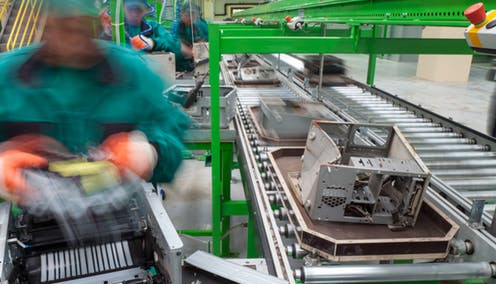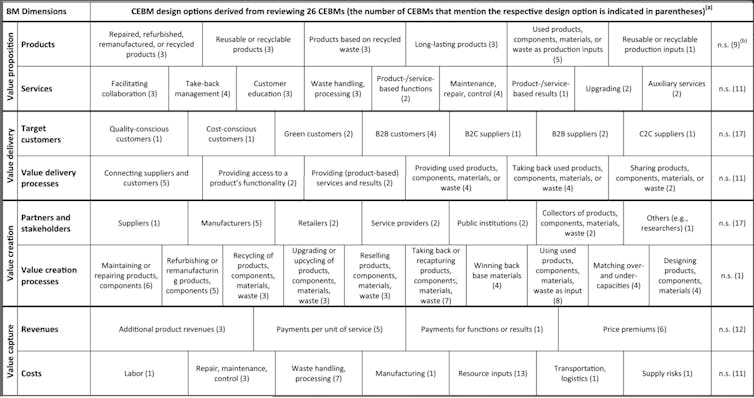Many ideas for the design of business models for the circular economy have been put forward. Some are based on case studies, others derived from theory. But why is it so difficult to provide a comprehensive overview of circular economy business models? The answer is simple: because there are so many of them.
We explored their variety in an April 2018 article in the Journal of Industrial Ecology (freely available through 2019). Together with Prof. Stefan Gold and Prof. Nancy Bocken, we reviewed the circular economy literature and found 26 major business model types, including for example “remanufacturing”, “waste exchange”, and “product-as-a-service”. These business model types reveal a lot about the numerous design options for the development of circular economy business models.
This is important not only for researchers, but also – and maybe much more so – for supply chain managers, business and product developers, innovation managers, and other practitioners working to make their businesses more sustainable. An astonishing variety of design options was found, including numerous value propositions, customer relationships, or supply chain approaches to close material and energy flows. Theoretically speaking, this variety allows for the development of more than 4 million different business model designs for the circular economy.
Complex, but a rich source for creativity
The notion of the circular economy is not new and can be traced back to early approaches in the field of industrial ecology, which promotes eco-industrial parks and other concepts to mimic nature’s principles in human activities since the early 1990s. But the translation of ideas such as closed material and energy flows or dematerialised products into business activities is a rather new phenomenon. This idea is supported by non-governmental organisations such as the Ellen MacArthur Foundation as well as a growing number of policies and regulations, which explains the growing interest shown by firms around the globe.
One of the main challenges of practically implementing circular economy principles is rethinking companies’ supply chains, and as a consequence the way they create and deliver value through their business models. This is because generations of engineers, operations managers, and business administrators spent decades or even centuries on optimising forward supply chains that conduct resources and goods “from cradle to grave”, and not from “cradle to cradle”.
For companies to create more circular production and consumption systems, they must develop and improve the reverse flows of their supply chains, and sooner or later that requires them to adapt their business models – for example, replacing non-renewable with renewable inputs, using recycled materials and creating products that are easier to refurbish or remanufacture. Companies can even replace physical products with less material-intensive services. A well-known example is Interface Inc, which offers floor-covering services rather than carpets.
Obviously, as soon as customers and their needs are affected, companies have to reposition themselves in the marketplace and adjust their logic of creating (economic) value with and for their customers, while they try to maintain natural resources and do less harm also in social terms. As our review shows, changes on the production side are rather invisible to customers and other stakeholders, and can lead to the need to rethink a company’s business model.
Needless to say, this is a complex endeavour, and the questions are endless:
-
Do we have to change our forward and reverse supply chains?
-
Should we do it now, or only when regulators and customers ask us to do so?
-
Can we improve our competitive position by moving toward closed-loop supply chains?
What is required is careful analysis and also the willingness to take the risks of business transformations – which are brilliantly described in two books by Ray Anderson, the late founder and chairman of Interface. Our research cannot answer these questions in general as they are highly case-dependent.
Still, we can offer an overview of the many design options that business and product developers, innovation and sustainability managers can choose from to create their own circular economy business model. Once companies are willing to dig deeper and search for the business potential of the circular economy, they will understand that these design options can become a rich source for creativity and future business success.
Turn the “morphological box” into a “magical design box”
Based on a systematic review of journal articles, policy briefs, and practitioner studies, we identified 12 publications that explicitly deal with distinguishable types of circular economy business models. We included these in a so-called morphological analysis, identifying business model characteristics that were repeatedly described in these publications and searched for recurring patterns, such as replacing products through services, using recycled materials, offering function-based pricing, and many more. This analysis led to the morphological box shown below.
Morphological box of circular-economy business-model (CEBM) design options. Notes: (a) CEBMs can be assigned to multiple options per business model dimension; totals per dimension do not always add up to 26. (b) The abbreviation Journal of Industrial Ecology/Wiley
To read the graphic, note that business models typically consist of :
-
A value proposition (the offering made to customers)
-
Value delivery activities (to bring the offering to customers)
-
Value creation activities (to engage necessary stakeholders and make use of resources leading to the offering)
-
Value capturing logic (for instance, describing the costs and revenues of a business model and how the company tries to make a living).
This all is shown in the left “BM bimensions” column. What turns this morphological box into a “magical design box” is the fact that each row – for example, for the value proposition – contains different options to design the business model element in question. We found six product and nine service options to design value propositions. These include, for example, refurbished products and take-back management services.
These design options can obviously be combined. A company can offer refurbished products (such as Back Market, a source for refurbished smartphones) and at the same time, take-back services (something Back Market is working on.
It follows that the many design options we found offer a huge number of combinations. Our review is not exhaustive, but even so, the design options shown above allow for 4,445,280 combinations. (Based on 6 × 9 × 7 × 6 × 7 × 10 × 4 × 7, choosing one option per dimension and not checking for inconsistent or illogical combinations). This incredible variety turns our morphological box into a magical design box for business model designers.
Do not take this number too seriously, as we do not – not every combination makes sense or can be implemented in practice. However, it’s a powerful illustration of two facts:
-
The emerging domain of circular business model design is incredible, which makes comprehensive overviews such a messy but important task.
-
The dazzling variety of options should motivate action researchers and practitioners of all sorts to get creative and test different business model designs along their journey toward more sustainable business.
What’s next?
This study is just one part of a larger research project on so-called “sustainable business model patterns” conducted at the Chair for Corporate Sustainability at ESCP Europe, Berlin. For example, teams are exploring a broader set of 45 patterns to support sustainability-driven business model innovation, the role and relevance of business model patterns to make companies more stakeholder-inclusive, as well as to promote more sustainable consumption. Our business model patterns have already been integrated into an online business modelling tool, to make them available for sustainable business model designers.



 Japan Exports to U.S. Rebound in November as Tariff Impact Eases, Boosting BOJ Rate Hike Expectations
Japan Exports to U.S. Rebound in November as Tariff Impact Eases, Boosting BOJ Rate Hike Expectations  Yen Near Lows as Markets Await Bank of Japan Rate Decision, Euro Slips After ECB Signals Caution
Yen Near Lows as Markets Await Bank of Japan Rate Decision, Euro Slips After ECB Signals Caution  Robinhood Expands Sports Event Contracts With Player Performance Wagers
Robinhood Expands Sports Event Contracts With Player Performance Wagers  Chinese Robotaxi Stocks Rally as Tesla Boosts Autonomous Driving Optimism
Chinese Robotaxi Stocks Rally as Tesla Boosts Autonomous Driving Optimism  Oil Prices Climb on Venezuela Blockade, Russia Sanctions Fears, and Supply Risks
Oil Prices Climb on Venezuela Blockade, Russia Sanctions Fears, and Supply Risks  Dollar Holds Firm Ahead of Global Central Bank Decisions as Yen, Sterling and Euro React
Dollar Holds Firm Ahead of Global Central Bank Decisions as Yen, Sterling and Euro React  Asian Currencies Slip as Dollar Strengthens; Indian Rupee Rebounds on Intervention Hopes
Asian Currencies Slip as Dollar Strengthens; Indian Rupee Rebounds on Intervention Hopes  Trump Orders Blockade of Sanctioned Oil Tankers, Raising Venezuela Tensions and Oil Prices
Trump Orders Blockade of Sanctioned Oil Tankers, Raising Venezuela Tensions and Oil Prices 

































